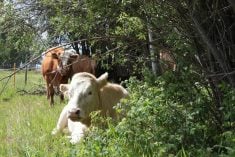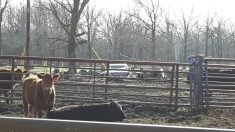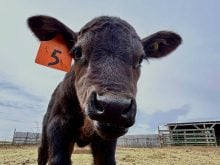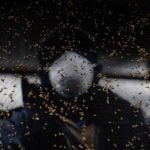The Callicrate bander was developed for a safe, blood-free method of castrating larger bull calves in both the beef and dairy industries. It’s a procedure that producers and processing crews can be trained to do, but veterinarians in some clinics still do lots of castrations with the bander or by other surgical methods.
We know that the advent of banding brought a huge increase in the incidence of tetanus. I would say tetanus was rare in clinical veterinary practice before banding. But if using it, we can overcome tetanus by pre-vaccinating with a clostridial vaccine that must contain tetanus.
Read Also

Cancer agency reclassifies another herbicide ‘probably carcinogenic’
The WHO’s cancer research agency has now put atrazine, a herbicide well known to corn growers, in the same potential-hazard category where the agency put glyphosate.
Along with castration, it’s been found that banding can be used in many other areas of livestock production. There are different makes and different size of banders (and rings), depending on the application. Most would be done by or under the supervision of a veterinarian. Unless it is an emergency, myself and most other veterinarians would still recommend the tetanus vaccination protocol before banding.
Most uses of the Callicrate bands involve removal or amputation of something without surgery. Little or no blood loss is an important side benefit. A person needs to use common sense when using the device and try to reach the ideal tension (proper band size) for the task at hand. Full tension may be required for some things similar to castration, but other uses might only require partial tension. As I will explain, we don’t want it to cause removal too quickly.
Many banding applications
A couple of emergency uses for the bander in bovine practice are for uterine or rectal prolapses where proper use of the tool for amputations can save the animal’s life.
With a badly torn uterus or where a prolapse has been out too long or damaged, I have seen a custom-made bigger band applied around and between the cervical rings to control bleeding as the uterus is amputated. Your veterinarian must first check to make sure no small intestines are inside the uterus. If repairs can’t be made, this treatment is performed as a last resort.
Use of the bander in this fashion usually involves rare situations during calving season. The band is left inside the cow and as swelling goes down, it will eventually be expelled through the vagina.
When dealing with a prolapsed rectum, most times it should be put back into place, but if badly torn, veterinarians have developed pipe devices with grooves which go into the lumen. As a band is applied and tightened, the pressure allows the damaged prolapsed part to slough off over several days.
If done correctly, the tissue has time to heal and the pipe comes out when the amputated rectal tissue falls away.
The difference in treating a prolapsed uterus is that your veterinarian is involved to amputate the large uterus distal and apply the band. The stump will essentially fall into the vagina. There will be no need to stitch this in. Non-steroidal anti-inflammatory drugs, (NSAIDS) and antimicrobials recommended by your veterinarian will be used. This may vary depending on your vet’s experience in the field.
Removals of external tumours or masses are examples of other cases where a bander could be used. Use on an external tumour is determined on a case-by-case basis. Is there enough loose skin allowing a band to be applied? In some cases when I’ve been worried about blood loss during surgical removal, applying the band is a safe alternative.
After a tissue biopsy, banding can also be used to remove a benign but growing tumour. Just like with castration, tight pressure applied by the band over three to four weeks allows the tumour to fall off or be removed with little surgery. If the band is stretched too far, it may lose its elasticity and not quite complete the job.
A very large papilloma (wart) as well as very small warts can also be removed by the properly sized band. Warts on the penis may be handled the same way but one must be extremely cautious to not include the urethra and stop urine passage, which would be fatal.
In the right situation, several small green bands can be used on some smaller equine umbilical hernias. Of course this would be done under anaesthesia to relax the horse, making it possible to roll the animal on its back to make sure everything is out of the hernial sac.
Finally, I have seen bands applied to facilitate dehorning as they are placed around the base of the horn. If used for dehorning, a pain block or at least an NSAID should be administered, as the procedure no doubt hurts when rings are put on. I’ve seen it done without NSAIDs and afterward the cattle did lots of head shaking. Costs are a bit higher, as two bands per horn per calf were used, but in a situation where the producer doesn’t want an open wound or bleeding, two rings will fit. A local pain killer or blocking agent is needed.
There are probably lots of additional band uses that I haven’t thought about. Hopefully, some day the lidocaine-impregnated bands will be available in Canada, which would add to the animal welfare/humane treatment component in my eyes.















